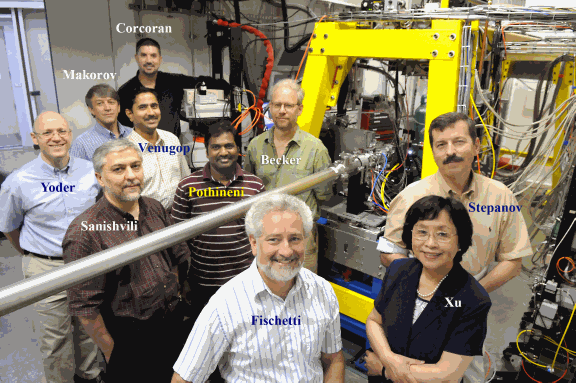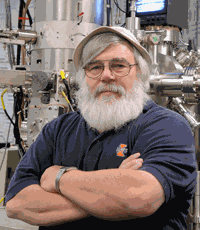Two innovative x-ray technologies that enhance science's ability to study large biological proteins and nanomaterials have won R&D 100 awards, regarded as the "Oscars of invention," for the U.S. Department of Energy's (DOE's) Argonne National Laboratory.
The awards recognize the top scientific and technological innovations of the past year as judged by a team of independent experts for R&D Magazine. Argonne scientists have won 108 R&D 100 awards since they were first introduced in 1964.
"I want to congratulate all of this year's winners on their awards and to thank them for their work," Energy Secretary Steven Chu said. "The large number of winners from the Department of Energy's national labs every year is a clear sign that our labs are doing some of the most innovative research in the world. This work benefits us all by enhancing America's competitiveness, ensuring our security, providing new energy solutions and expanding the frontiers of our knowledge. Our national labs are truly national treasures, and it is wonderful to see their work recognized once again."
Hard X-ray Quad Collimator
The advent of high-quality, third-generation x-ray sources, such as the DOE's Advanced Photon Source (APS) at Argonne, has provided new advantages to protein crystallographers. One such benefit is the use of mini x-ray beams, which can be created in two ways: by using optical elements to reduce the focus size of the incident x-ray beam or by using collimating devices to sample portions of a focused beam.
The Hard X-ray Mini-beam Quad Collimator developed by researchers from the Argonne BioSciences Division, the General Medicine and Cancer Institutes Collaborative Access Team at Sector 23 of the APS, and the University of Michigan narrows the APS x-ray beam to a user selectable "minibeam" of 5, 10, or 20 micrometers in order to facilitate the study of extremely small protein crystals or to locate the best part of a heterogenous crystal. The quad collimator also allows the process of selecting the correct collimator aperture size for a given protein crystal size to be automated.
The collimator consists of three essential components: a uni-body quad collimator, a magnetically indexed kinematic mount, and a precision motion system. The system provides micron-sized beams of various sizes to a sample. It is compact, durable, and economical, and its motions are reproducible and precise at the micron level. It can be placed on x-ray beamlines such as those at the APS or other x-ray sources.
Funding was provided by National Institute of Health's National Institute of General Medical Sciences and National Cancer Institute.
The Hard X-ray Mini-beam Quad Collimator was jointly developed by a team from Argonne and the Life Sciences Institute of University of Michigan. The principal developers from Argonne are Robert Fischetti, senior physicist; Shenglan Xu, principal beamline engineer; Nagarajan Venugopalan, protein crystallographer; Derek W. Yoder, beamline specialist; Ruslan Sanishvili, protein crystallographer; Michael Becker, protein crystallographer; Craig Ogata, protein crystallographer; Sergey Stepanov, controls group leader; Oleg Makarov, principal control systems developer; Mark Hilgart, software developer senior; Sudhir Pothineni, software developer senior; and Steve Corcoran, engineering specialist. The principal developer from the University of Michigan is Janet L. Smith, director of the Life Sciences Institute.
See: R.F. Fischetti, S. Xu, D.W. Yoder, M. Becker, V. Nagarajan, R. Sanishvili, M.C. Hilgart, S. Stepanov, O. Makarov, J.L. Smith, "Mini-beam collimator enables microcrystallography experiments on standard beamlines," J. Synchrotron Rad. 16 (2), 217-225 (2009). DOI: 10.1107/S0909049508040612
See also on the APS website: In Nature: Fischetti on Minibeams
Contact: [email protected]
Nanoscientist Nestor Zaluzec of Argonne's Materials Science Division and his colleagues won an R&D 100 award for their development of a nanoparticle detector.
The π Steradian Transmission X-ray Detector
Also garnering an R&D 100 award was Argonne's π Steradian Transmission X-ray Detection System, an innovative transformation of a technology used by the scientific community for 40 years. This R&D 100 winner significantly improves the ability of researchers to study nanomaterials. For the majority of scanning electron microscopes, transmission electron microscopes and scanning-transmission electron microscopes used today, more than 98 percent of the available x-ray signal from the microscopes is neglected.
Under conditions where signal is plentiful, this loss may not be a major issue. However, for studying minute quantities of material or materials that are beam-sensitive, such as nanoparticles and catalysts, or during time-sensitive measurements, the magnitude of the available signal becomes a limiting factor in an analysis.
Argonne's technology solves this problem by increasing the detection of available signal during micro/nanoscale analysis of ultra-small particles and films as much as 500 times. This is particularly important when using the sub-nanometer beams available in today's atomic resolution electron-optical beam lines.
Funding for this research was provided by DOE's Office of Science.
The principal developer is Nestor J. Zaluzec, senior scientist at Argonne's Electron Microscopy Center.
Contact: [email protected]
The Advanced Photon Source at Argonne National Laboratory is one of five national synchrotron radiation light sources supported by the U.S. Department of Energy's Office of Science, Office of Basic Energy Sciences (DOE-BES). The APS is the source of the Western Hemisphere's brightest high-energy x-ray beams for research in virtually every scientific discipline. More than 3,500 scientists representing universities, industry, and academic institutions from every U.S. state and several foreign nations visit the APS each year to carry out applied and basic research in support of the BES mission to understand, predict, and ultimately control matter and energy at the electronic, atomic, and molecular levels in order to provide the foundations for new energy technologies and to support DOE missions in energy, environment, and national security. To learn more about the Office of Basic Energy Sciences and its x-ray user facilities.
The Electron Microscopy Center (EMC) for Materials Research develops and maintains unique capabilities for electron beam characterization and applies those capabilities to solve materials problems. The EMC staff perform collaborative research with members of the Materials Science Division, other Divisions at Argonne and with collaborators from universities and other laboratories. The expertise and facilities of the EMC additionally serve a group of national and international researchers. The EMC emphasizes three major areas: materials research, technique and instrumentation development, and operation as a national research facility. Research by EMC personnel includes microscopy based studies in high Tc superconducting materials, irradiation effects in metals and semiconductors, phase transformations, and processing related structure and chemistry of interfaces in thin films.
Argonne National Laboratory seeks solutions to pressing national problems in science and technology. The nation's first national laboratory, Argonne conducts leading-edge basic and applied scientific research in virtually every scientific discipline. Argonne researchers work closely with researchers from hundreds of companies, universities, and federal, state and municipal agencies to help them solve their specific problems, advance America 's scientific leadership and prepare the nation for a better future. With employees from more than 60 nations, Argonne is managed by UChicago Argonne, LLC for the U.S. Department of Energy's Office of Science.


